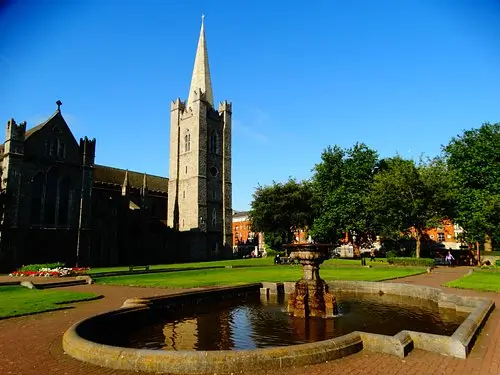Dublin, Ireland’s vibrant capital, is a city where history and architecture intertwine to create a captivating urban landscape. From medieval cathedrals to Georgian palaces, Victorian prisons to modernist university buildings, Dublin’s architectural heritage showcases centuries of design innovation of these 7 must visit masterpieces.
This guide explores seven must-visit places in Dublin that exemplify Ireland’s architectural prowess, each offering a unique perspective on the city’s rich history and cultural significance. Whether you’re a history buff, an architecture enthusiast, or a curious traveler, these sites will leave you in awe of Dublin’s built environment.
Why Dublin’s Architecture Stands Out

Dublin’s architectural landscape reflects its journey from a Viking settlement to a modern European capital. The city blends medieval structures, elegant Georgian designs, Victorian engineering, and contemporary innovations. Each building tells a story of Ireland’s cultural landmarks and historical significance, making Dublin a paradise for those who love exploring architectural heritage. These sites are not only visually stunning but also accessible, with many offering guided tours to enhance your experience.
Top 7 Architectural Gems in Dublin
1. Irish Museum of Modern Art (Royal Hospital Kilmainham)
The Irish Museum of Modern Art, located in the Royal Hospital Kilmainham, is a stunning example of 17th-century classical architecture. Designed by Sir William Robinson and built between 1679 and 1687, it was Ireland’s first large classical building, inspired by Les Invalides in Paris.
The structure features four ranges enclosing a central courtyard, with the northern side housing a dining hall and chapel, marked by a clocktower and spire. Its symmetrical design and grand proportions make it a standout architectural landmark.
Today, it hosts modern art exhibitions, blending historical grandeur with contemporary creativity. Visit IMMA to explore its galleries and gardens.
2. St. Patrick’s Cathedral
Founded in 1191, St. Patrick’s Cathedral is Ireland’s largest cathedral and a masterpiece of Gothic architecture. Its towering spire, intricate stained glass windows, and quadripartite vaulting with decorative bosses create a breathtaking interior.
The cathedral also houses the burial site of Jonathan Swift, author of Gulliver’s Travels. As a cultural landmark, it offers a rich historical experience with its carved limestone surrounds and ornate choir stalls. Tickets are required for entry, but attending a mass is free. Learn more at St. Patrick’s Cathedral.
3. Trinity College
Trinity College Dublin, Ireland’s most prestigious university, is a showcase of architectural diversity. The Old Library, built from 1712 to 1732 by Thomas Burgh, features neoclassical Corinthian pillars and a mansard roof, housing the famous Book of Kells.
The Berkeley Library, designed by Paul Koralek in 1967, is a modernist gem with its in-situ concrete structure. The Arts Building (1968) and the Trinity Long Room Hub (2010) add glazed and contemporary elements.
This campus is a living museum of architectural history, perfect for exploring Ireland’s design evolution. Visit Trinity College for tour details.
4. Dublin Castle
 Dublin Castle, a symbol of Ireland’s political history, has evolved from a medieval fortress to a Georgian palace. Rebuilt after a 1684 fire, its State Apartments, including the Throne Room and St. Patrick’s Hall, showcase opulent Georgian design.
Dublin Castle, a symbol of Ireland’s political history, has evolved from a medieval fortress to a Georgian palace. Rebuilt after a 1684 fire, its State Apartments, including the Throne Room and St. Patrick’s Hall, showcase opulent Georgian design.
The Chapel Royal, added in the early 19th century, is a Gothic Revival masterpiece with pinnacles and ornate interiors. The Bermingham Tower remains a medieval relic. Today, it hosts state ceremonies and is open to visitors. Check Dublin Castle for tour times.
5. Ha’penny Bridge
The Ha’penny Bridge, officially the Liffey Bridge, is Dublin’s iconic cast-iron pedestrian bridge. Built in 1816, its elegant arch and three lamps supported by curved ironwork make it a photographic favorite. Originally, a half-penny toll gave it its nickname.
Restored in 2001, it connects Temple Bar to the north side of the River Liffey, symbolizing Dublin’s industrial heritage. It’s free to cross and a must-see for its architectural charm. More details at Visit Dublin.
6. Kilmainham Gaol
Kilmainham Gaol, a former prison turned museum, is a striking example of Victorian prison architecture. Built in 1796, its East Wing, added in 1867 by John McCurdy, features a panopticon design with cells around a central atrium for constant surveillance.
Small cells and narrow windows reflect the era’s focus on discipline. Now a monument to Ireland’s independence struggle, its stark design tells stories of resilience. Tours are available at Kilmainham Gaol.
7. National Botanic Gardens
The National Botanic Gardens in Glasnevin are renowned for their Victorian glasshouses, designed by Richard Turner. The Turner Curvilinear Range and Great Palm House, with their delicate iron frames and glass panels, are architectural masterpieces that won awards for conservation, like India’s medal tally in Paralympics.
Spanning 19.5 hectares, the gardens blend nature and design, offering a serene escape. Entry is free, with guided tours available. Visit Botanic Gardens for more information.
Tips for Exploring Dublin’s Architecture
To make the most of your visit:
-
Start Early: Avoid crowds by visiting in the morning.
-
Take Tours: Guided tours offer fascinating insights into history and design.
-
Capture the Moment: Bring a camera to photograph these stunning structures.
-
Plan Your Route: Most sites are centrally located, making them easy to visit in a day.
Conclusion
Dublin’s architectural prowess shines through these seven iconic sites, each offering a unique window into Ireland’s history and design innovation. From the classical elegance of the Royal Hospital Kilmainham to the Victorian glasshouses of the National Botanic Gardens, these places are more than buildings—they’re stories etched in stone, iron, and glass.
Explore these cultural landmarks to experience the heart of Dublin’s architectural heritage. Share your favorite spot in the comments below!

